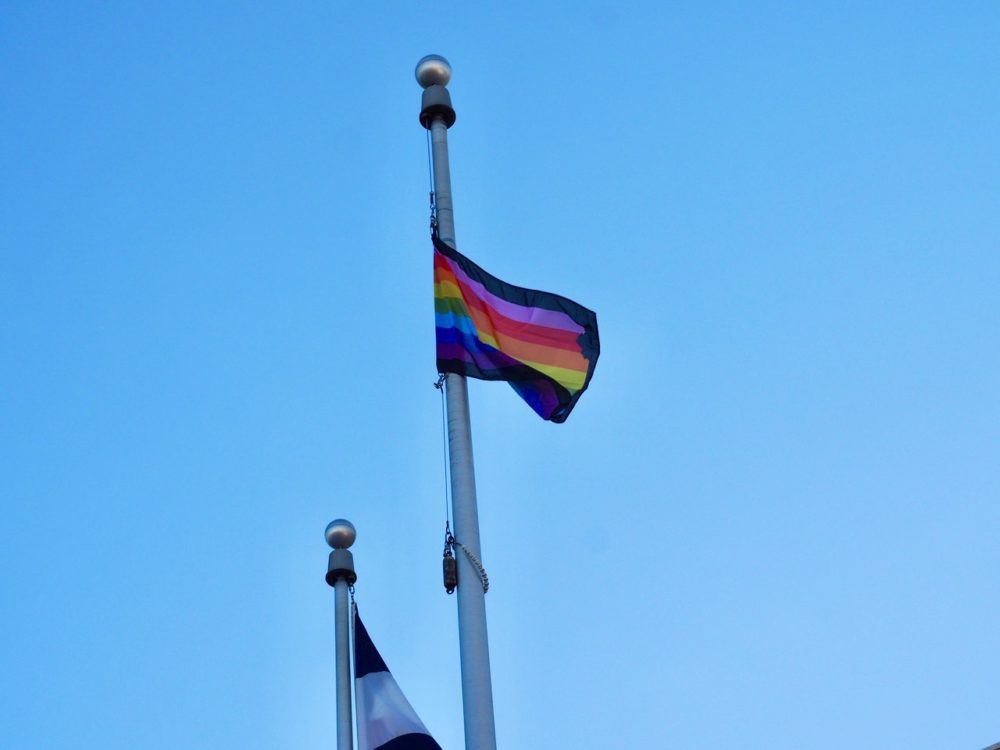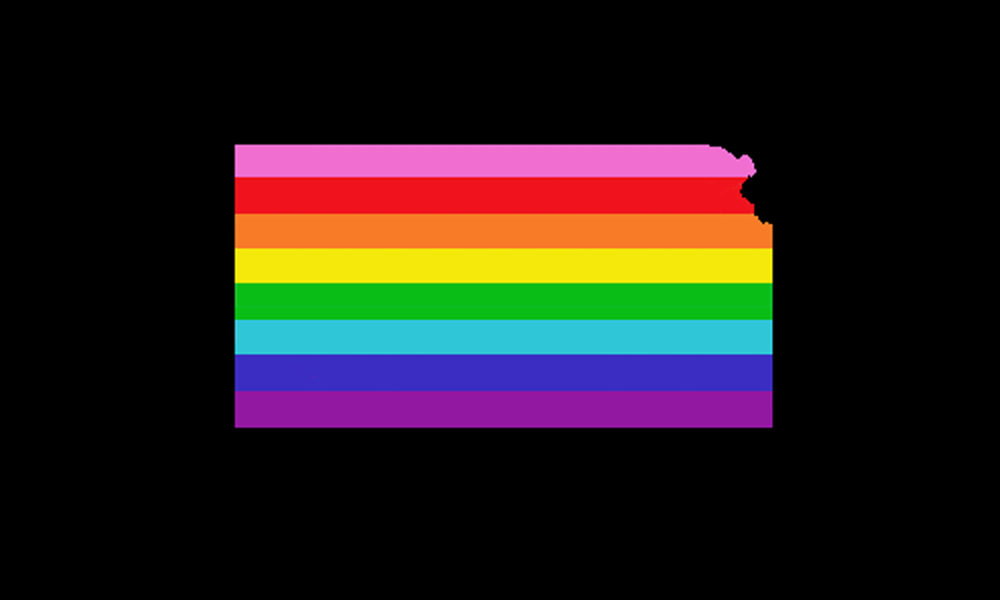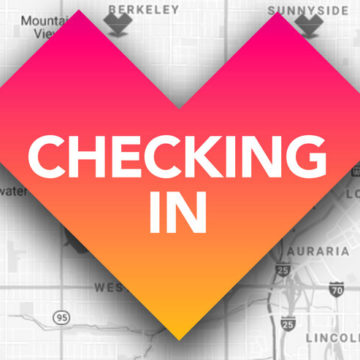
This artwork was made in homage to Gilbert Baker, who created the first rainbow flag for the LGBTQ+ community. It is part of MOA’s collaboration with RedLine Contemporary Art Center’s “Checking In” progressive exhibition, featuring work of several regional artists at various host sites throughout the Denver Metro area.
"Gilbert Baker Flag"
by Genevieve Waller
2020
Fabric
Information

On display December 15, 2020 through February 15, 2021.
Located on Civic Center Flag Pole
The History of the Rainbow Flag
Do you know the artist who created the rainbow flag?
Gilbert Baker was born in Chanute, Kansas in 1951 and had an early interest in art and fashion. He also knew from a very young age that he was gay. After graduating from high school in Kansas, he was drafted into the army where he served as a medic and was stationed in San Francisco. He continued to live in San Francisco after his military service ended and became part of the gay activist community there. He created costumes, joined the Sisters of Perpetual Indulgence (an activist drag performance group), and through his political involvement he was asked to create a positive symbol for the gay and lesbian rights movement. With a team of friends, he dyed fabric and sewed together the first Rainbow Flags which were used in the San Francisco Gay Freedom Day Parade in 1978.
The original flag included 8 colors—each symbolizing a different aspect of the diverse lesbian, gay, bisexual, and transgender movement. Due to availability of certain color dyes and fabrics, Baker later simplified the design to 6 colors: red, orange, yellow, green, blue, and violet. He intentionally did not copyright the flag in order to allow the general public to use and proliferate the new LGBT symbol.
For the next several decades, Baker worked on various projects using the Rainbow Flag, including the creation of a mile-long flag in 1994 to honor the 25th anniversary of the 1969 Stonewall Riots in New York City which sparked the contemporary gay rights movement. In 2003, he produced an even larger flag for the Key West Pride celebration in Florida, commemorating the 25th anniversary of the flag itself. This flag was able to reach from the Gulf of Mexico to the Atlantic Ocean. He was also invited to be the grand marshal of various U.S. and international pride celebrations.
One lesser-known project is the series of flags that Baker created for almost all of the U.S. states, the District of Columbia, and for the U.S. principalities of American Samoa, Guam, the Northern Mariana Islands, Puerto Rico, and the Virgin Islands. Most of the designs are based on the existing flags, with Baker adding rainbow elements to small details or filling large areas of color with rainbow stripes. For the Colorado state flag, Baker left the iconic letter C intact, but exchanged its solid red for a rainbow starting with violet and its inside yellow circle for white, all on a traditional Rainbow Flag background.
Gilbert Baker passed away at his home in New York City in March 2017, just a few months before he was scheduled to appear at the inaugural Gilbert Baker Film Festival in his hometown of Chanute, Kansas. His memoir Rainbow Warrior: My Life in Color was published by his estate and Chicago Review Press in 2019.
The Evolution of the Rainbow Flag
In the original Rainbow Flag, the symbolism of the 8 colors were as follows:
Hot Pink = Sex
Red = Life
Orange = Healing
Yellow = Sunlight
Green = Nature
Turquoise = Magic and/or Art
Indigo = Serenity
Violet = Spirit
In the 1980s, Baker added a black stripe to the flag to represent the AIDS crisis. Another common variation has been a combination of the U.S. and Rainbow Flags, where the white stars on a blue rectangle remain but rainbow stripes replace the red and white ones. In 2017, there were two more significant variations to the Rainbow Flag. First, Gilbert Baker added a lavender stripe to the original 8-color flag to represent diversity and as a response to the 2016 U.S. presidential election. Then, artists led by Amber Hikes added black and brown stripes to the 6-color flag to represent communities of color in the LGBTQ+ community after a group of young people of color were kicked out of a Philadelphia gay bar.
The flag continues to evolve, with the addition of other colors, chevrons, and representations of other flags including the Transgender Pride Flag.
Other Flags
Transgender Flag
While there have been a number of flags symbolizing transgender people and activism, the most well-known is the Transgender Pride Flag created by Monica Helms, a trans woman, in 1999. It features two pink and two light blue stripes that signify the 20th century connotations of pink=female and blue=male, while a central white stripe stands for those who do not fall within this gender binary, including those who are transitioning their gender, those who are intersex, and those who have a non-binary gender.
Bisexual Flag
Created in 1998, the Bisexual Pride Flag includes a pink stripe at the top denoting same-sex attraction, a blue stripe at the bottom for opposite-sex attraction, and a lavender strip in the middle representing the overlapping of pink and blue and the mix of attraction to same and opposite sexes.
Artist’s Statement
This year, I’ve been creating a series of flags dedicated to Gilbert Baker—the artist who created the Rainbow Flag. Baker was born in my home state of Kansas and, like me, grew up there. Many people do not know the history of the flag, who Gilbert Baker is, or the fact that the flag’s inventor came from a state that’s not known as LGBTQ-friendly.
In addition to the Rainbow Flag, Baker also created Pride flags for almost all of the U.S. states and principalities, incorporating rainbow details into each state flag design. With the flags I’ve made celebrating Gilbert Baker, I want to raise awareness of this artist and his creation of an international symbol of LGBTQ+ pride.
Artist’s Biography
Genevieve Waller is an artist, writer, historian, and curator. She creates photograms (cameraless photographs), sculpture, drawings, and videos that deal with excess, substitution, transparency, and the status of everyday objects. Originally from Wichita, Kansas, she received an undergraduate degree in art history at Wichita State University, a M.F.A. in photography and art history at Ohio University, and a M.A. in visual and cultural studies at the University of Rochester. She spent a year in Berlin, Germany as a Fulbright grantee and for many years has been a college radio DJ. Currently, she resides in Denver, Colorado where she is a member of Secret Love Collective and the founder of the art journal DARIA: Denver Art Review, Inquiry, and Analysis.
